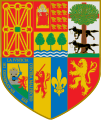Plik:Zazpiak Bat.svg
Wygląd

Wielkość pliku podglądu PNG dla pliku SVG: 504 × 600 pikseli Inne rozdzielczości: 202 × 240 pikseli | 403 × 480 pikseli | 645 × 768 pikseli | 860 × 1024 pikseli | 1721 × 2048 pikseli | 579 × 689 pikseli.
Rozmiar pierwotny (Plik SVG, nominalnie 579 × 689 pikseli, rozmiar pliku: 1,38 MB)
Historia pliku
Kliknij na datę/czas, aby zobaczyć, jak plik wyglądał w tym czasie.
| Data i czas | Miniatura | Wymiary | Użytkownik | Opis | |
|---|---|---|---|---|---|
| aktualny | 22:42, 30 kwi 2009 |  | 579 × 689 (1,38 MB) | SanchoPanzaXXI~commonswiki | retoque lobos |
| 20:31, 30 kwi 2009 |  | 579 × 689 (1,39 MB) | SanchoPanzaXXI~commonswiki | rediseño | |
| 21:52, 28 lis 2007 |  | 550 × 650 (384 KB) | SanchoPanzaXXI~commonswiki | {{Information |Description={{en}}Modern version of en:Zazpiak Bat insignia. From the Basque words zazpiak meaning "the seven ones" and bat meaning "one", translates as "the seven ones [are] one", refers to the seven historical Basque Country territor |
Lokalne wykorzystanie pliku
Następujące strony korzystają z tego pliku:
Globalne wykorzystanie pliku
Ten plik jest wykorzystywany także w innych projektach wiki:
- Wykorzystanie na ar.wikipedia.org
- Wykorzystanie na bs.wikipedia.org
- Wykorzystanie na ca.wikipedia.org
- Wykorzystanie na da.wikipedia.org
- Wykorzystanie na en.wikipedia.org
- Wykorzystanie na en.wikiversity.org
- Wykorzystanie na eo.wikipedia.org
- Wykorzystanie na es.wikipedia.org
- Euskal Herria
- Escudo de Navarra
- Usuario:Keat
- Usuario:Ultrasiete
- Usuario Discusión:Martiko
- Wikiproyecto:Euskal Herria
- Wikiproyecto Discusión:Euskal Herria
- Wikiproyecto:Euskal Herria/Userbox2
- Usuario:Tximist
- Usuario:Ignaciojd3
- Usuario:Zarateman
- Usuario:Janfri
- Zazpiak Bat
- Usuario:Rikku~eswiki
- Usuario Discusión:Tximist
- Wikiproyecto Discusión:Euskal Herria/Discusiones2
- Portal:Navarra/Portales Relacionados
- Portal:País Vasco
- Portal:País Vasco/Portales relacionados
- Inmigración vasca en Chile
- Usuario:Marine13
- Usuario:El-Numero
- Xabi Aburruzaga
- Usuario:Pablitop
- Usuario:Aberzale
- Usuario:Igalix/Archivo de 2007-2010
- Usuario:Userbox/Localización/España
- Usuaria:Userbox mujer/Localización/España
- Koruko Ama Birjinaren Eskola
- Usuario:Raulsalvatierra1998
- Usuario:Sejuzu
- Jean de Jaurgain
- Armorial de las familias vascas
- Usuario:Gogoter
- Wykorzystanie na eu.wikipedia.org
Pokaż listę globalnego wykorzystania tego pliku.

